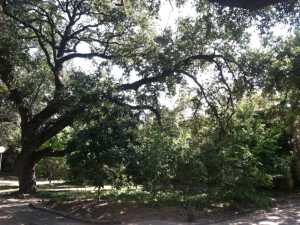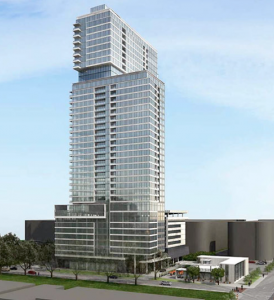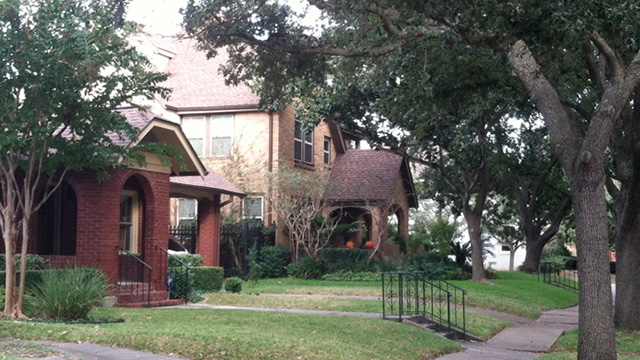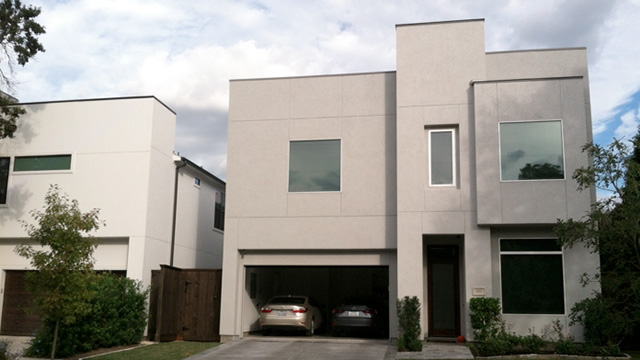This post first appeared at AlterNet.
A startling change for the worse has occurred in the physical appearance and occupancy of central Houston over the last few years. Entire historic neighborhoods, while superficially modernized, have had their character destroyed. How can change on this scale take place so fast, despite the lessons of the recent national housing collapse? Who are the people behind this transformation, how do they get what they want, and who gets hurt by their callous disregard?
My neighbors and I are currently being affected by what I consider the most monstrous example of gentrification in Houston. I want to expose its sordid aspects, hoping that Houston will do the right thing and that other cities in the early stages of gentrification will take note of what is at stake.
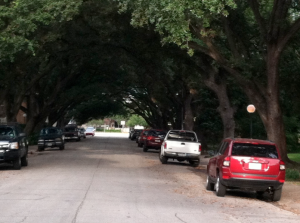
Steel Street at the intersection of Kirby and Alabama, in the heart of Houston’s cultural district: Thirty-five 100-year-old live oak trees dominate the street amidst historic 1940s housing set to be torn down. (Anis Shivani/May 2014)
Artists, writers and eccentrics from around the country descended in droves in the 2000s to take advantage of Houston’s livability. They flocked to the legendary “gayborhood” of Montrose and brought other neighborhoods around downtown to life. I called Houston in those halcyon years “Austin-plus” because it had a lot of the capital’s aesthetic attractions in addition to remarkable diversity and friendliness. Despite the influx of the creative class, Houston remained affordable and blissfully free of alienation.
Alas, for many of us the dream has ended. Houston has transmogrified into a city ruled by a brutal strain of neoliberalism, and the city’s well-known tendency to be disrespectful of history has been taken to gothic extremes. It took only a few short years for developers to displace the original population of the central neighborhoods, while converting the core city into an exclusive playland for the rich.
The metamorphosis has received little coverage in local media, which are beholden to the same growth-at-all-costs advocates who fund politicians. Houston now has comparable rents to New York City, and corporate indifference — which I had never known since I moved here almost 20 years ago from New England — stamps out neighborhood intimacy. Houston has ceased being what it was, as rampant commodification destroys its inherent Southern gentleness and live-and-let-live philosophy.
Gentrification is the process of replacing deteriorating inner-city housing stock with upscale residences — townhouses and condos — while the original lower-income residents are evicted. Gentrification, as it started occurring in North American cities in the early 1970s (following the lead of London in the 1960s), goes through certain well-known cycles, typified by what happened to New York’s Lower East Side. In the first wave, gentrifying pioneers (typically educated and older, intrigued by the cultural possibilities of the inner city) move back from the suburbs, followed by a younger wave of gentrifiers (students and artists) who give the inner city a stronger cultural aura, followed at last by yuppies and then even richer and more homogeneous upper-class people for whom moving in has more financial than cultural meaning.
What is happening in Houston does not fit the classical definition of gentrification. Montrose — the quintessential bohemian district — is close to historic wards like the third, fourth and fifth, home to generations of minority homeowners. The condition of these neighborhoods was nothing like the slums of Los Angeles or Detroit, despite the damage caused by freeway construction after the war. There were isolated areas of blight, but on the whole they were vital and functioning. The bohemian areas were ideal as they were.
To call what is happening gentrification or even redevelopment dignifies the current violence. When existing vibrant neighborhoods are torn down and those being displaced are crucial members of the community, we’re not just talking about gentrification. We are witnessing a full-scale sellout to developers, who are working closely with municipal government for short-term speculative gain.
* * * * *
Houston’s geographical patrimony is up for sale to the highest bidder, and politically unaccountable corporations are in a purchasing frenzy. Boosters rationalize their investments as a means of broadening the tax base or making the city more attractive for business, but in fact the city is being hollowed out for future generations. This is asking for big trouble, as we will recognize when the bubble inevitably bursts. By then the mega-builders will have made their pile of cash and moved on to other cities to destroy whatever is humane and urbane about them. Houston is late to the game, but this is the same process of leveraged gain for the few leading to profound human misery for the many.
Houston’s bohemian section (Montrose) is adjacent to our most elite neighborhood (River Oaks), both of which are in turn close to the inner-city neighborhoods; this juxtaposition once created possibilities for interaction among different classes. The geographical jumble made segregation all the more difficult once it started being phased out in the 1950s, which had a positive influence on the rest of the city as well, radiating beyond the inner loop of the 610 freeway. But Houston has undergone dramatic resegregation under the guise of development.
My neighbors on Steel Street — at the Kirby and Alabama intersection, arguably the single most desirable location in Houston, with everything interesting located within a few miles’ radius — and I have become victims of the grotesque leveraging of urban space by those who falsely assert that the market alone decide outcomes.
There is no prettier street in all of Houston, with a magnificent vista that opens up as one enters Steel Street from Kirby Drive or Virginia Street; people mention North and South Boulevards as comparisons but the trees on our street are more impressive. Family members of Roy Huffington, the renowned Texas oil baron and philanthropist, are said to have lived in the very townhouse I live in (they combined adjoining townhouses and made delightful alterations including cavernous bookshelves). Even River Oaks does not have a contained urban forest such as this one, so it’s no wonder that the Dickey family, which owns all of the property on the street, invited their friends from River Oaks to maintain residences here.
In the 1890s, William Dickey, a physician, bought a huge tract of land alongside Kirby Drive stretching all the way to Buffalo Bayou, including parts of River Oaks and the Avalon neighborhood and what is known as Upper Kirby. Upon the death of William Dickey’s son in 1999, the current owner, Tommy, started selling chunks of this vast property bit by bit, taking advantage of tax incentives to “redevelop” a large stretch of Kirby Drive, from River Oaks to the 59 Freeway.
Such tax incentives (called TIRZ’s, Tax Increment Reinvestment Zones) are common to the gentrification narrative in other cities so it’s disingenuous to claim that market forces alone determine outcomes. Municipal policies guide urban transformation, spurring developers to focus on areas that are already well-developed. Before Dickey started selling it off in pieces, Kirby Drive already had thriving independent restaurants and businesses. Perverse tax incentives for the destruction of distinctive neighborhoods should have no place in rational urban planning.
Our immediate neighbor, a pretentious luxury condo called Gables River Oaks (they keep changing names, hoping that the next one will lure in occupants), remains largely empty, and the retail businesses within it keep closing down. The new residents have little loyalty to local businesses. And an infamous high-rise building that went up on Kirby remains largely empty five years after construction, so it’s not as if the development is all in response to pent-up demand from young professionals moving into Houston by the tens of thousands.
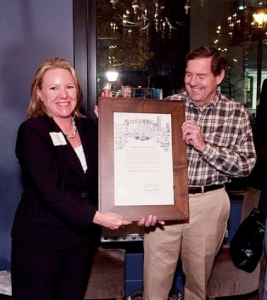
Tommy Dickey, the current owner of Steel Street, often recognized by the city for his contributions to “redeveloping” the already elite Upper Kirby area. (Upper Kirby District Street Talk/2011).
Tommy Dickey tried for a while to get the city to “abandon” Steel Street, so that the oak trees would no longer be in the right of way and the developer could do whatever he wished with them. He met with success at last when Hanover Co., with presumable help from the planning commission, came up with a scheme that would fly: present the plan as developing only a portion of the street, get everyone accustomed to the idea of losing the incredible vista, and take care of the rest piecemeal.
Before the planning commission meeting on August 21, the developer announced that only five trees would be affected, and that the high-rise involved only a section of Steel Street. Since then, however, things have been moving rapidly, as the rest of the property has been sold off. Dickey apparently didn’t hold out for a higher price for the rest of Steel Street, afraid of possible resistance.
The planning commission meeting was a revelation to me. I have never seen a more hardened bunch of 27 people gathered in one place (city council members often seem to have their hearts in the right place, but this is not so with the planning commission). Developers make their pitch (the proposals are predeveloped, formed in conjunction with the city to offer whatever suits public consumption, as was true of gentrification in New York and elsewhere) and the planning commission staff invariably rubber-stamps it. Members of the public are free to comment but the commission may go ahead with the original decision anyway.

All over Montrose and Upper Kirby one sees boosters carrying signs on the streets, as empty luxury apartment towers try to lure in occupants. (Anis Shivani/Nov. 2014)
Hanover’s representatives, primarily David Ott, came off as gangsters dressed in nice suits. They made obvious misrepresentations while the planning commission just sat there and took it with a wink and a nod. Hanover claimed that an arborist had done a study for them showing that the trees would be “helped” and “improved” by construction. It isn’t hard to imagine that in a few years the company will say that the trees are dying — which they surely will because of the damage caused by the construction — and should be taken down for public safety.
A man rose in support of the highrise as a member of the “Steel Street Townhome Owners’ Association”; he may belong to a part of Steel Street on the other side of Kirby, but has nothing to do with our section of Steel Street. The planning commission (headed by Patrick Walsh, director of Planning and Development) asked politely if the public would continue to have access to the trees (assuming they would continue to exist) and Hanover replied that the public would be happier than ever. I imagine a ghastly private walkway like the one at Gables River Oaks, the trees (if any survive) nestled amidst failing high-end stores for the private enjoyment of those who can afford a million-dollars-plus for one of the 370 units in the high-rise.
But Houston is not known for leaving well enough alone. Three years ago I was traveling to national parks in the mountain west and came back to discover that the entire tree cover for Memorial Park — oaks that were planted in the 1920s by the city fathers — was gone! The drought had supposedly killed the trees and they were in danger of falling over runners so the city had to prevent the risk. I haven’t encountered anything like Memorial Park’s vast acreage of ancient trees anywhere in the country. There is no such place, in the dead center of urban density, set aside in quite the same manner, yet in the blink of an eye, without public discussion, the trees were demolished. It became an excuse to “redevelop” Memorial Park; Council Member Ellen Cohen (who wants to be the next mayor) is a fierce advocate for this $150 million boondoggle, courtesy of a New York company. The idea is to take down pristine ecological systems and rebuild them for commercial ends.
Council Member Cohen (whose district includes most of the central neighborhoods that have been devastated) is a recurring presence in these scenarios. Buffalo Bayou Park, connecting downtown with River Oaks/Upper Kirby/Montrose, was another ecological treasure, yet — without much public input — its pristine wilderness was also demolished, leaving a massive redevelopment project in its wake. There was a bit of a fuss about the riparian forest that will give way to commercialization, but this being Houston, the conclusion was foregone.
* * * * *
It has become almost a rite of passage for liberal-minded Houstonians to get a 30-day eviction notice. Over on Steel Street, my neighbor Angela works at Whole Foods and has three young daughters, one of whom attends the prestigious Lanier Middle School. Angela has been preparing her daughters for a massive downgrade and is even considering abandoning her nine-year-old dog. Like many others here, Angela has little idea of how to proceed because there is no affordable housing within the city. Buying is out of the question, as tiny houses cost half a million dollars and decent-sized houses a cool million.

Long-time Steel Street resident Angela Tawater Amundsen with her 13-year-old daughter Emma. (Anis Shivani/Nov. 2014)
Kat Kearns is an artist who has had a tough time finding a place that would accept her rescue dog Birdie. Eddie Graber, with a law degree from UT Austin, has lived here for 40 years, and cannot comprehend the loss. Don Williams lived here for 30 years and was proud of his vegetable garden. Mark (a University of Houston graduate student in literature) and his yoga-teaching wife Lisa also grew a vegetable garden; they have since reluctantly departed to east Houston, the reservoir du jour for the displaced. My next-door neighbors have had three children since they moved here and are unlikely to find any comparable housing elsewhere in the city.
We are real people who make up a real community, only to be displaced by unoccupied zombie high-rises which are pure investment vehicles for global investors. People like us find our lives irreparably damaged by gentrification. We’re not homeless, we’re not welfare recipients, we’re the backbone of Houston, tens of thousands of hardworking residents who put the city in the position of promoting itself as a cultural destination in the first place. We ride bikes or walk; we loyally support local establishments; we love our neighborhoods and treasure them, yet we are the ones whose lives are destroyed.

The real faces of displacement: the Hodge family, my immediate neighbors, Willow, Sidney and Oliver, in front of their house on Steel Street. (Liana Bouchard/Nov. 2014)
In Portland or San Francisco lawsuits would be flying all over the place to save the trees. But the ordinary citizens of Houston feel powerless amidst the development frenzy. Houston’s center has already been transformed beyond recognition,with countless skyscrapers going up, while the original population has been dispersed to distant ramparts or are considering other cities now that Houston has become as unaffordable as Los Angeles or New York.
In Montrose there has been a precipitous decline in foot traffic — which leads to more crime — because the yuppies are content to turn their backs to the world, preferring windowless standardized townhouses, and patronizing establishments that close down early in the evening (because they have to go to their oil and gas industry jobs early the next morning). Taco Milagro, at the intersection of Kirby and Westheimer, used to be a lively public-private space. The food was very healthy and people from all over the city danced the night away and congregated on the large patio. But at the gateway to River Oaks, with condominiums going up all around, this open space was unacceptable, so Taco Milagro suddenly shut down.
This is how ruling oligarchies kill a city: one business, one person at a time, pretending that market forces are doing all the work, when in fact all sorts of incentives and disincentives are at play. Certain websites — Culturemap.com in particular — have emerged during the same period as cheerleaders for gentrification. Culturemap sent Houston’s leading society reporter, Shelby Hodge, to take pictures of the doomed trees, while breathlessly cheering on the Hanover high-rise as a great favor to the environment. The commentators at the real estate site Swamplot.com are often boosters locked into the developers’ myopic viewpoint; not a day has gone by in recent years when Swamplot hasn’t reported the closure of yet another historic restaurant or bar or antique shop. But after about five years of this, there’s nothing distinctive left to shut down anymore.
Like the Houston Heights, one of the earliest planned communities in Texas (which has had its own troubles with gentrification), the entire Montrose/Upper Kirby area, along with the neighborhoods surrounding downtown, should long ago have been declared historic neighborhoods, untouchable by developers. This would have preserved vital public space which is now gone forever, replaced by a scale of construction that does not suit a quintessentially low-key, low-density city like Houston.
If the city were truly interested in broadening the tax base and making it a metropolis with lasting appeal, it would focus on improving the old neighborhoods outside the 610 loop. Incentives should be provided to increase livability and expand the range of options for every class of people. Instead, those neighborhoods remain static and ignored, while the mega-developers keep tearing down and rebuilding the stock of inner-city housing that is already solid. The logic of gentrification is to continuously package and commodify and leverage the same bit of land for speculative purposes. Save the neighborhoods that need to be saved and leave those that are doing great alone.
Unfortunately, that isn’t the narrative that is being promoted. Once developers’ spokespeople — like David Ott of Hanover — preemptively reach out to local media to provide what are essentially press releases for new developments, media outlets consider their reporting job finished. The glossy arts magazines cater to the vanities of the nouveau riche rather than question an issue which goes to the base of the wealth of the very people who fund them. Television is missing from this conversation, as is progressive radio. An organization called Preservation Houston has carefully kept distance; supported by the rich folks in River Oaks, they seem interested only in fighting minor battles to embellish their own reputation rather than challenging the real balance of power among the different forces. It remains to be seen if organizations like Trees for Houston will remain content to plant saplings in remote suburbs rather than take forceful legal action in a transformative case like this one.
The final indignity is that while only a part of the street is to be used for the high-rise, all the rest of us have received summary eviction notices. This is gratuitous violence against helpless tenants. Some say that demolition will save them property taxes, but how do you measure the suffering of tenants who have lived here for decades against some tax savings, if that is even the case? If we’d had more time, we would have made better choices. No doubt it will take several years before the high-rise is finished, so the majority of tenants on the rest of the street did not need to be evicted now.
The real reason for urgent eviction is to make the destruction of the idyllic aspect of Steel Street a fact and kill any potential protest. This is in keeping with the rough style of the mega-developers. The evictions alone should be grounds for a lawsuit, as would happen in a more progressive city. I’m sure I’ll be visiting the ruins of Steel Street a year from now and see little in the way of actual construction.
How beautiful Houston could have been, how livable, how egalitarian, how aesthetically and environmentally pleasing; in parts of the city one can see signs that we could easily have been a greener Portland of the South. The city can still choose to go the humane way and secure its future, which does not come from short-term gains in property values and associated tax revenues but creating the kind of place that people fall in love with. Despite the city’s benign indifference, such a spirit already existed and flourished, but it’s been stabbed to death.
Houston used to work despite the low-wage, low-service economy, but the unaffordable cost of living spells an end to that path. The distant corporate types who have taken over will not be around when the fiscal crunch soon comes. To be a world-class city, Houston’s political leadership must care about leaving behind a social geography derived from the real sum of human endeavor, not abstract financial maneuvers. Let us not dignify high-stakes real estate deals which destroy the lives of ordinary citizens with the word “gentrification.”
Mega-developers like Hanover should be taught a lesson so that this sort of cavalier treatment of precious environmental resources ceases. Will Houston media and activist organizations step up? Will the city do the right thing by calling it off and preserving the entire street, both the trees and the historic housing? Will interested lawyers take up the cause? Hanover will claim in a couple of years, once the construction has done its damage, that the trees were always dying (though they’re as strong as ever, sprouting fresh growth even now), and request the city to abandon Steel Street at last.
Houston happens to have an enlightened mayor, Annise D. Parker, and I hope she will put these bread-and-butter issues squarely on the table. This is a struggle against the power of corrupt oligarchies that are erasing every trace of distinction about Houston. Our entire land-use policy should be up for reconsideration. Houston cannot become a mature city until it introduces equality between the business elite and the low-wage workers who have been exploited since the city’s formation.
Should landlords be allowed to evict tenants with decades worth of residency in just 30 days? Substantial compensation is the least they should be offered, but the first resort should be to allow tenants to form co-ops and buy the properties they have proudly cared for. Tenants should know from the outset what is in the works rather than be confronted with facts after the game is over. In our case, we received setback variance notice on August 11 with the hearing set on August 21 — this small window being our only chance to have our opinion heard (and that too on a matter of detail, not the larger issue of whether construction should take place). That is the only point where the public intersects with the city. Predeveloped proposals should be disbarred as manifestations of outright corruption.
There is a way to grow without destroying natural resources and harming vulnerable citizens. Mature cities undertake balanced growth to create shared prosperity, rather than benefit only the global financial elites. In addition to declaring all of Steel Street, both the trees and the housing, as untouchable historic landmarks, Mayor Parker should give thought to the following basic initiatives in the spirit of developing a more progressive urban policy:
- Projects with a huge public impact should be available for review well before the final stage. Neighborhoods should be equalized rather than pitted against each other.
- An arbitration committee should provide a mechanism for future disputes between neighborhoods and developers, to reduce the power of developers working through the planning commission. The planning commission’s arbitrary powers should be severely curtailed.
- Rents should be regulated in central districts to retain the kind of people who create urban vitality. A plan should be set in place to make aesthetically appealing housing available at modest cost in historic neighborhoods, in order to counter renewed segregation.
- There is talk of legislation to do away with even the current minimal checks on developers’ powers, such as weakening of historical preservation guidelines and setback variance rules. Instead, the opposite direction should be pursued to prevent developers from converting beautiful neighborhoods into instant wastelands.
- Property conversion should have to follow restrictive new guidelines so that the constant cycle of tearing down and building up to inflated proportions can be rechanneled into citywide development of culture and infrastructure.
The views expressed in this post are the author’s alone, and presented here to offer a variety of perspectives to our readers.


